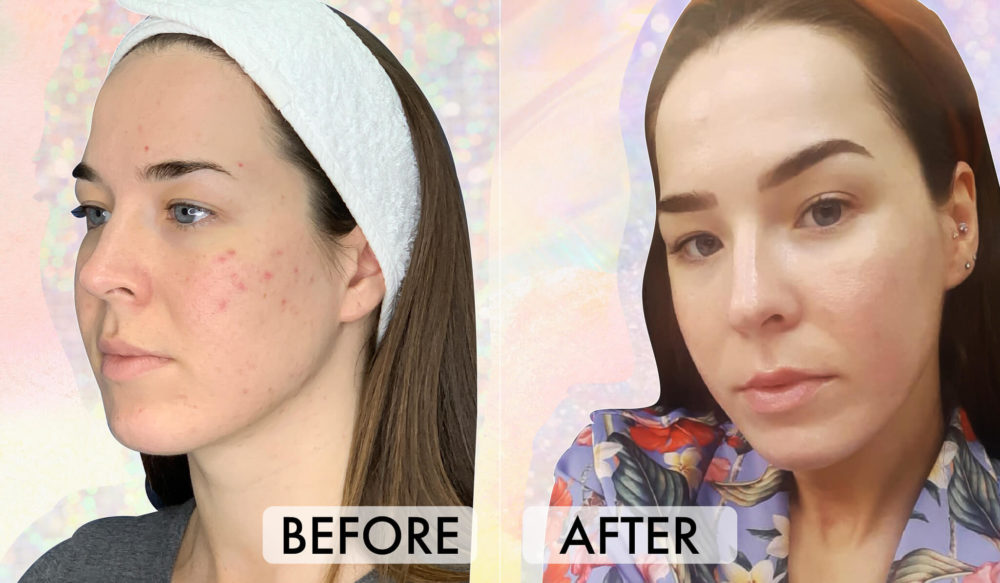This Is The Real Reason Your Skin Is Breaking Out
 via Giphy
via Giphy
Have you ever started using a new product in quest of perfect skin, and then it actually triggers a breakout? Well, if this has happened to you, your skin could be ‘purging,’ not breaking out. Don’t worry, the mistake is easy to make as a purge and a breakout look pretty similar. However, they should be treated differently, and a purge is not necessarily a bad thing. A purge is essentially a reaction to an ingredient in a product, whereas a breakout is when your pores are infected with acne bacteria. We spoke to celeb board-certified dermatologist and author of Beyond Beautiful, Dr. Doris Day for all the info. Here’s how to know the difference and never make the same mistake again:
What a purge looks like…
“A purge is a reaction from a product. It can be an irritant reaction to a product, leading to piling up of skin cells and their underlying contents. It can be due to an imbalance of water in the skin, an imbalance of the way the cells exfoliate or an imbalance of elements within the skin. It’s not bacterial related and is an entirely different process than acne, even though they can look very similar,” Dr. Day tells us. Deep cystic acne or very red, inflamed or painful acne are often related to a breakout, whereas small red bumps and whiteheads are more common characteristics of purging.
What a breakout looks like…
Dr. Day told us, “A breakout starts as an abnormal sloughing of the skin cells of the lining of the pores, which are actually tiny hair follicles. Those pores/follicles are lined with skin cells, and they also are attached to oil glands called sebaceous glands (at their base). Those oil glands empty into the pores, and their contents end up on the surface of the skin and can act as natural moisturizer for the skin. One other element living at the base of the follicle is a bacteria called P. Acnes. This bacteria only grows under conditions of low to no oxygen. When the skin cells are sloughing off properly, everything moves along, and the bacteria doesn’t grow. Once the cells stop moving along as they’re supposed to, the opening to the surface of the skin gets closed off, everything behind gets backed up, and access to oxygen is cut off, allowing the bacteria to now grow. This is the basis of whiteheads, blackheads, and pimples.”

Other than the appearance of the breakout or the purge, it can be helpful to consider if you’ve made any other changes in your daily routine, like:
- Have you started using a new product? The products that are most likely to trigger a purge are retinol and any products containing AHAs or BHAs (as they increase skin cell turnover), which is why you should introduce these products to your regime gradually.
- Have you started using a new cleansing tool? A lot of people experience a purge when they start using a new cleansing tool, like the Clarisonic as it can be quite abrasive on the skin.
- Have you started taking any medication? Medication or any method of contraception can seriously impact your skin, so make sure you factor this is when determining whether your skin is purging or breaking out. Find out more about the impact of contraception on your skin here.
- Have you made any lifestyle or diet changes? Remember, a breakout can be triggered by eating certain foods. Make sure you’re not eating these five foods that trigger breakouts.

What to do when your skin ‘purges’
Firstly, Dr. Day recommends, “Take a break from the offending product. Then once the skin has improved, restart using the product but start slowly, once a day or every other day and use just a little. Build up to the recommended use, as tolerated. Layer with other protective products such as skin hydrators that contain hyaluronic acid.”
Posts You'll Love:
According to Dr. Day, “You should also consider changing the products you use in summer vs. winter. In the summer there’s typically more humidity. Also, the skin sweats more in the summer, and one of the elements that end up on the skin is called natural moisturizing factor. This helps the skin hydrate itself and helps the skin function better with lighter or even no moisturizer during the summer months. In the winter and at night, when you naturally lose more water from your skin as you sleep, you may need richer moisturizers.”
“I often recommend a topical cortisone cream which you can buy from most pharmacies or online here, $5, as an anti-inflammatory to help clear the purge more quickly. A purge can last for days to weeks depending on how sensitive your skin is and how strong the product is, and also based on what you use to treat it.”
Check out this post on how to deal with breakouts, and if the problem or irritation is ongoing, we recommend seeing a dermatologist.
Don’t forget to comment below on what skincare concern you’d like us to write about next!























Leave a comment